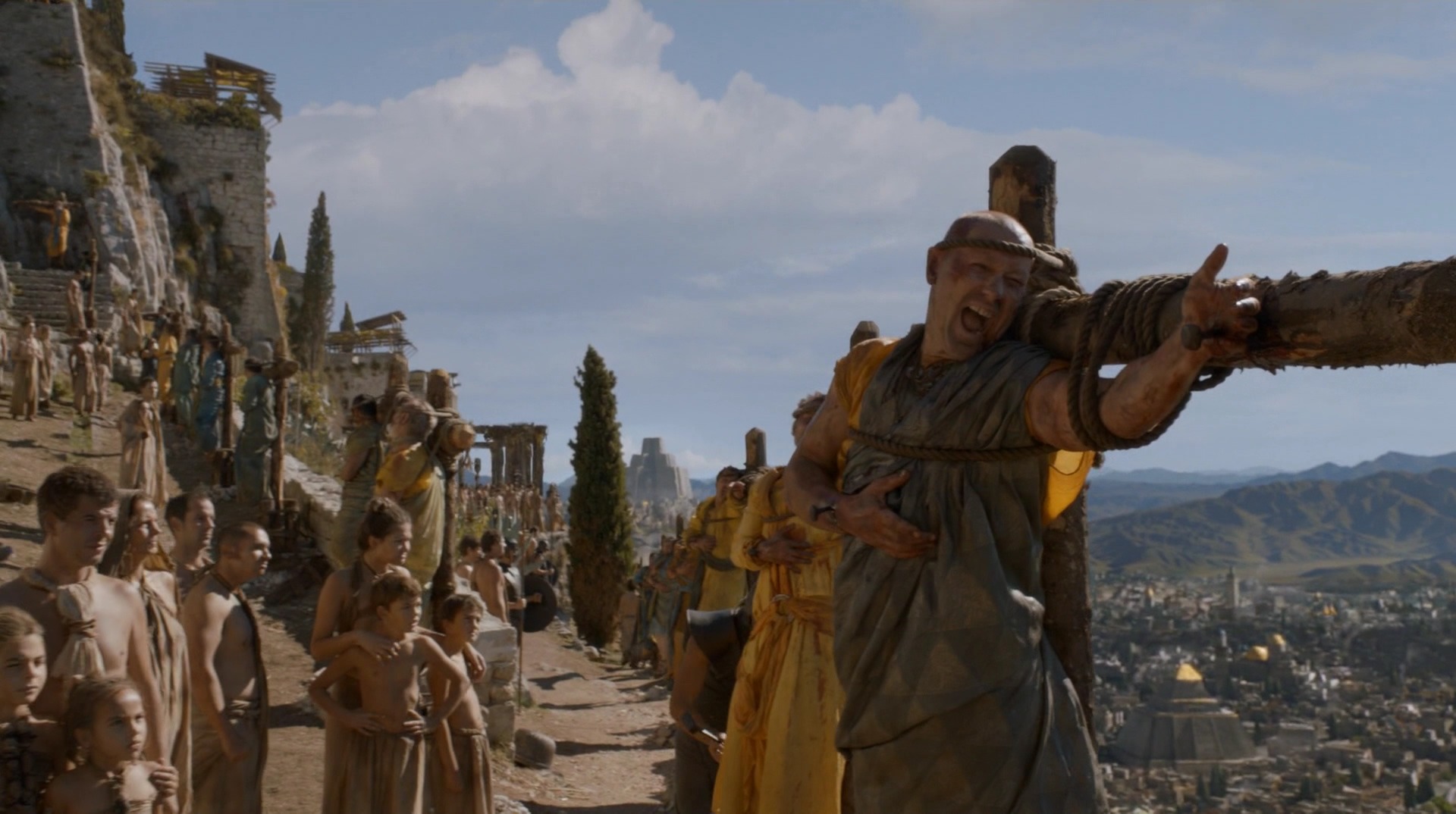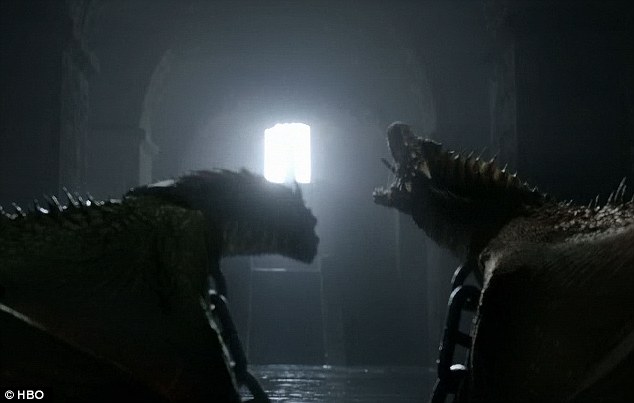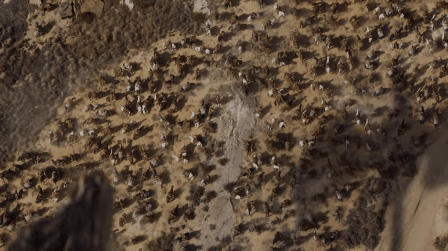
Daenerys Targaryen is not fireproof. How could the showrunners reuse a plot device from Season 1? Fan-Fiction!
These are the common complaints that A Song of Ice and Fire fans have on Daenerys’ fateful confrontation with the khals from Game of Thrones’ “Book of the Stranger.” It is also a scene that I, myself, had trouble swallowing the first time I watched it.
Up until the 54 minute mark: "This is the best Game of Thrones episode since R'hllor knows when."
After: "Goddamn it, Game of Thrones."
— BryndenBFish (@BryndenBFish) May 16, 2016
However, upon re-watching the scene and re-reading Daenerys’ final chapter from A Dance with Dragons, I believe that this scene is in keeping with the best traditions of A Song of Ice and Fire and visually communicates Dany’s internal thematic transformation extraordinarily well, much as Game of Thrones has successfully done time and again.
Themes in Dany’s Journey

Outwardly, Daenerys’ journey has been one of triumph, forward progression and by the end of A Dance with Dragons/Season 5, a thematic return towards the start of her character arc. Rising from frightened girl married off to a brutal warlord to mother of dragons and powerful Queen of Meereen before returning to her Dothraki roots, Daenerys has run the gamut of experiences.
Inwardly though, Dany’s character arc is one of internal struggle over her identity. Throughout the first five books/seasons, but especially in A Storm of Swords, A Dance with Dragons and Seasons 4 and 5 of Game of Thrones, Daenerys struggles with who she is and who she should be. Is she Aegon the Conqueror Reborn: the Mother of Dragons spitting fire and blood against her enemies? Or is she the mhysa, attempting to peacefully rule a divided and angry people?
This question of who she is dominates her internal monologue in A Song of Ice and Fire and is often explored visually or in dialogue in Game of Thrones through thorny moral issues of vengeance and her dragons in Meereen.
How Game of Thrones Effectively Communicates Daenerys’ Conflict from ASOIAF

One of the best examples of how George R.R. Martin and Game of Thrones attempted to show Dany’s character journey is the crucifixion scene from A Storm of Swords/Season 4. If you’ll recall from that scene in the books and the show, Daenerys has conquered Meereen, but along the way she’s witnessed the horrors along the road. The Great Masters crucified 163 children to the mileposts to Meereen. So, when she finally takes Meereen, she fatefully decides to exact vengeance for the deaths of the children by the Great Masters by crucifying 163 Meereenese.
In A Storm of Swords, the scene occurs entirely from the perspective of Daenerys herself and much of it occurs inside her head. In her internal monologue, Dany contrasts her catharsis brought by vengeance with her disgust when she saw what that very same vengeance wrought:
She had them nailed to wooden posts around the plaza, each man pointing at the next. The anger was fierce and hot inside her when she gave the command; it made her feel like an avenging dragon. But later, when she passed the men dying on the posts, when she heard their moans and smelled their bowels and blood . . .
Dany put the glass aside, frowning. It was just. It was. I did it for the children. (A Storm of Swords, Daenerys VI)
In Game of Thrones, Season 4, the scene had to be played out visually. Instead of Daenerys internalizing her thoughts, Barristan Selmy stands in as the voice for mercy and reminder that “sometimes it is better to answer injustice with mercy.” Daenerys, in full avenging dragon mode, responds:
“I will answer justice with justice.”
The important takeaway from both A Storm of Swords and Game of Thrones, Season 4 is that both communicated the satisfaction and righteousness of vengeance as well as communicated the horror of the act.
The Thematic Importance of Chaining the Dragons

However, this crucifixion scene in both the books and show stands in contrast to how Daenerys attempts to govern Meereen. She faces a mounting insurgency by the Sons of the Harpy and finds to her horror that her dragons kill innocent children. This outward struggle mirrors her internal conflict. As a queen, Dany’s conflict with herself broadly revolves around the concept of dragon (avenging conqueror) versus mhysa (peaceful ruler willing to make hard sacrifices).
This conflict is explored in detail at various points in A Dance with Dragons and Game of Thrones, but the way it’s explored differs. For purposes of brevity, let’s explore one pivotal scene found in both Game of Thrones and A Dance with Dragons: Dany’s chaining of the dragons. In both mediums, Daenerys’s decision to chain her dragons plays a major role in her crisis of identity.
To recap, a man approaches Daenerys and presents the charred bones of his daughter to Dany. To her horror, the man recounts that Drogon, one of Dany’s dragons, burned and ate his daughter. To prevent this from occurring again, Daenerys decides to chain Viserion and Rhaegal (Drogon has fled the scene of his crime). However necessary this act might have been to prevent the loss of innocent life, the act is incredibly painful to Daenerys. By chaining her dragons, Daenerys imprisons her only “children.” However, its a deeply symbolic act on Dany’s part as well. By chaining her dragons, Dany is chaining her identity as a draconic conqueror and restraining her impulse as a “dragon.”
In Game of Thrones, Daenerys, herself, leads her dragons into the dragon pit and places the iron collars around the necks of Rhaegal and Viserion. This is beautifully communicated by Ramin Djawadi’s mournful riff of Daenerys’ main theme as well and by Emilia Clarke’s sorrowful facial acting and back-turn/walk away from her dragons. However, when she turns back at the end of the scene towards her dragons, it signals that she has not fully embraced the imprisonment of her dragons. She pines for her dragons much as he pines to reclaim her chained identity.
Dany’s decision to chain her dragons in A Dance with Dragons is communicated almost entirely in internal monologue in the books. In fact, it occurs entirely off-page between Daenerys’ first and second chapters in A Dance with Dragons. However, when she finally thinks about her decision, it grates against her, but she rationalizes it as a means of chaining her own monstrosity:
Mother of dragons, Daenerys thought. Mother of monsters. What have I unleashed upon the world? A queen I am, but my throne is made of burned bones, and it rests on quicksand. Without dragons, how could she hope to hold Meereen, much less win back Westeros? I am the blood of the dragon, she thought. If they are monsters, so am I.
(A Dance with Dragons, Daenerys II)
Like Dany’s final turn and horrified look back into the dragonpit from Game of Thrones, Season 4, Dany is extraordinarily conflicted over chaining her dragons in A Dance with Dragons, but she justifies it as part of the price of peace in Meereen. However, this price aggravates Daenerys. In writing A Dance with Dragons, Martin layered Dany’s thematic conflict with metaphors of the dragons straining against their chains:
Down in the pit, Viserion had snapped one of his chains; he and Rhaegal grew more savage every day. (A Dance with Dragons, Daenerys IV)
“My children have grown wild and angry in the dark.” (A Dance with Dragons, Daenerys VIII)
This in turn mirrors Dany’s growing anger over the compromises she makes for peace in Meereen:
I hate this, thought Daenerys Targaryen. How did this happen, that I am drinking and smiling with men I’d sooner flay? (A Dance with Dragons, Daenerys VIII)
This is peace, she told herself. This is what I wanted, what I worked for, this is why I married Hizdahr. So why does it taste so much like defeat? (A Dance with Dragons, Daenerys VIII)
Both in the show and in A Dance with Dragons, these conflicts all come to a head in Daznak’s Pit as Daenerys flies from problems in Meereen towards a return to her beginnings. In the show, Daenerys’ relief as she leaves Meereen is clearly evident in Emilia Clarke’s facial acting. She’s leaving the battle behind much as she’s leaving Meereen behind.
In A Dance with Dragons, Dany identifies the feeling of flying away from Meereen as “the song of freedom.” It’s a happy experience for her but it’s also a thematically consequential one too.
Resolving Dany’s Internal Thematic Conflict

Turning towards her encounter with the khals, we see Daenerys make a fateful thematic turn that once again mirrors her internal conflict from A Dance with Dragons. Some fans of ASOIAF (to include myself initially) looked at this scene as a rehash of her march into Drogo’s funeral pyre from Season 1/Dany’s last chapter in A Game of Thrones. However, while there is a certain visual comparison to be made (a “conscious echo of 1×10” in the words of Dan Weiss) to Drogo’s funeral pyre scene, the better thematic comparison is Dany’s final chapter from A Dance with Dragons.
As we’ve seen time and again, Game of Thrones has conveyed many of the themes seen mostly in the thoughts of characters in A Song of Ice and Fire through visuals, music and invented dialogue. In this instance, the showrunners opted for all three to show Dany’s decisive turn towards fire and blood.
In A Dance with Dragons though, George R.R. Martin brought Dany’s crisis of identity to a head through a trippy internal monologue out on the Dothraki Sea. At the start of her chapter, Daenerys is with Drogon and attempts to fly back to Meereen. However, Drogon repeatedly brings her back to the Dothraki Sea:
She would sooner have returned to Meereen on dragon’s wings, to be sure. But that was a desire Drogon did not seem to share. (A Dance with Dragons, Daenerys X)
The writing on Martin’s part here is a literary cue that Dany’s thematic journey cannot take her back to Meereen yet. Why? Because she has an identity and a purpose to resolve on the Dothraki Sea first.
Similarly, Daenerys refuses to scamper away from Vaes Dothrak with Daario and Jorah in “Book of the Dead.” She certainly has a plot purpose in not running (gaining a giant khalasar), but there’s a thematic purpose too: accepting her role as a dragon and taking what is hers by fire and blood.
Back in A Dance with Dragons, Daenerys finally decides to walk towards Meereen. Along the way, she eats some mystery berries (they likely contain hallucinogenic properties) and begins her vision quest on the Dothraki Sea. In her mind, she encounters ghostly apparitions of Viserys Targaryen, Jorah Mormont and Quaithe. The literary purpose of the ghosts of Dany’s past is to persuade her to abandon the mhysa and re-embrace fire and blood.
In probably the most powerful and decisive dialogue in the books, Daenerys finally gives in to her desire to abandon Meereen and become a dragon again:
You took Meereen, he told her, yet still you lingered. “To be a queen.”
You are a queen, her bear said. In Westeros. “It is such a long way,” she complained. “I was tired, Jorah. I was weary of war. I wanted to rest, to laugh, to plant trees and see them grow. I am only a young girl.”
No. You are the blood of the dragon. The whispering was growing fainter, as if Ser Jorah were falling farther behind. Dragons plant no trees. Remember that. Remember who you are, what you were made to be. Remember your words.
“Fire and Blood,” Daenerys told the swaying grass. (A Dance with Dragons, Daenerys X)
The amusing portion at the end where Dany talks to the swaying grass is George RR Martin hinting to us that she is almost certainly hallucinating one or all of the ghosts she encounters. The greater thematic point, though, is that Daenerys has now embraced her fire and blood destiny. The end of her chapter shows that she’s no peacemaker. She’s a warrior, a conqueror and her stay in Essos is coming to an end. Daenerys has embraced violence to move forward, and this will have significant consequences in the books to come.
I have to imagine that Game of Thrones’ showrunners and writers agonized over how to portray Dany’s turn to fire and blood and perhaps tried to engage in some writing workshops to work through a few scenarios on how to make this transition as smoothly and cleanly in a visual medium. So much of what Dany discovers in her last chapter in A Dance with Dragons occurs inside her head.
The showrunners chose to use Dany’s immunity to fire as a plot-vehicle to speed her claim of a giant khalasar forward. Dany’s immunity to fire seems to have also been used as a means to visually show her shift in identity. In burning the khals at the end of the episode and emerging triumphant before a bowing congregation of Dothraki as Djawadi’s score soared above it, Daenerys revealed her turn way from the woman who sadly chained her dragons to avoid the deaths of more innocents towards someone willing to embrace violence. She had been reborn in Vaes Dothrak as Daenerys the Conqueror: the woman who will take what is hers by fire and blood.
It was an effective adaptation of a beautiful chapter from A Dance with Dragons, and the seismic thematic import will certainly be felt for the rest of Game of Thrones.
Conclusion
Now, of course, given that we don’t know for a certainty what Dany’s thoughts were at that scene, we can’t be fully sure that this is the exact note that the showrunners wanted to hit. However, we can speculate with some certainty that Daenerys’ journey will take her from Essos to Westeros. But before she can even arrive back in Meereen, she has one more fateful encounter she will have to make: Drogon.
Drogon provides both a literal vehicle for her journey back as well as a thematic vessel to drive Daenerys towards a greater sense of her fire and blood purpose and destiny. Drogon is Dany’s physical connection to her draconic identity and Daenerys will need to encounter Drogon again to solidify her thematic dragon connection. From the trailers, we know that Drogon is returning.

With Drogon’s return and Daenerys embracing her thematic purpose as a conqueror, her arc will lurch towards violence and war in Essos and eventually (finally) Westeros. In this, I believe that Game of Thrones will continue its stellar record of capturing the great themes revolving around Daenerys Targaryen’s destiny and purpose.
For more reading on Dany’s journey in A Dance with Dragons, I recommend the Meereenese Blot’s “Untangling the Meereenese Knot: Dany’s Struggle With Herself” as well as “Dragons Plant No Trees” on reddit. Many thanks to @ManuclearBomb and Game of Owns for inspiring this article!
BryndenBFish is the creator of the Wars and Politics of Ice and Fire Blog a blog dedicated to political and military analysis of A Song of Ice and Fire. He can be found on twitter as @BryndenBFish.
The post How a ASOIAF Fan Learned to Stop Worrying and Love S6E4’s Final Scene appeared first on Watchers on the Wall.
Via http://watchersonthewall.com
No comments:
Post a Comment